|
Vavuniya, the gateway to the North:
Restoring its pristine glory
By P. Krishnaswamy
Significant progress has been achieved in renovating irrigation
tanks, renovating roads to agricultural areas and bringing arable land
under the plough, Vavuniya district, District Secretary (DS), Bandula
Harischandra told the Sunday Observer. Thousands of acres of arable land
in the district are dotted with lakes, ponds or irrigation tanks with
most of the places named after them e.g. Rambaikulam, Marambaikulam,
Welikkulam, Puliyankulam, Veppankulam, Nelunkulam and Pavatkulam, the
suffix 'kulam' denoting a tank .
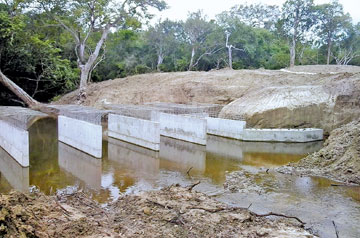
A causeway under construction |
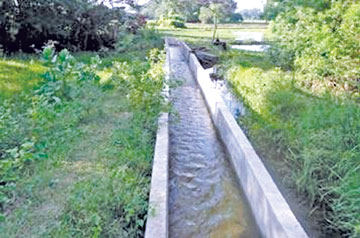
The Rajendrankulam agricultural scheme |
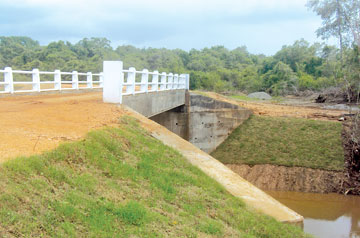
The Kiwoya Bridge on completion |
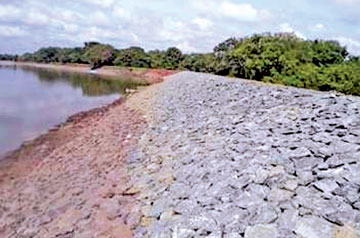
The Periyathambanaikulam Tank |
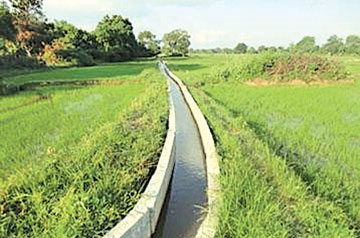
The Iratperiyakulam agricultural scheme |
He said development activities where the focus in recent months was
to complete several irrigation and agriculture -related projects since
the district is basically agricultural.
Improving other sectors including the road network, water supply,
electricity, health, education and civil administration was also taken
into consideration, the DS said.
Another landmark event is the preparation and distribution of land
permits to nearly 3000 families, in compliance with the recommendation
of the Lessons Learnt and Reconciliation Commission (LLRC), the DS said.
Minister of Industry and Commerce and MP for the Vanni District Rishad
Bathuideen has already issued land permits in respect of 250 families of
the Vengadacheddikulam Divisional Secretary (DS) division while land
permits in respect of 40 families in the Vavuniya South Tamil DS
division, 500 in respect of Vavuniya North DS division and 1184 in
respect of Vavuniya South Sinhala DS division have already been prepared
and ready for distribution, he said. These are permits to those who had
either lost their permits due to terrorist problems or had not
previously furnished proper details of their lands , the DS said.
Government allocation for the rehabilitation and reconstruction of
irrigation tanks, both major and minor, during the year 2013 is Rs.282.7
Mn and almost 98 percent work has been completed as at May 31, 2014
according to details furnished by the Planning Director of the Vavuniya
secretariat.
The funding is from the Ministry of Economic Development and the
World Bank. The tanks include Kalmadu tank , the Mahakachchakodiya tank
and the Galabogaswewa tank, according to the Director Planning.
The Vavuniya district was the gateway to the once terrorism ravaged
Northern province, is fast becoming the hub of economic and agricultural
activities, thanks to the several mega development programs launched by
the Government since the eradication of terrorism five years ago. These
investments facilitate the people to engage in increased productivity by
using improved Irrigation facilities, electricity and better road
network. Consequent to the Government's development programs, the
district has become significant in relation to its contribution to the
GDP in spite of the fact that it is comparatively smaller in extent viz:
1,967 Sq.Km having a population of 172,000, according to the secretariat
sources. Paddy cultivation is undertaken in an extent of 18544 Ha and
the annual production has reached 83,000 tonnes.
A major area of all abandoned arable lands have been cleared and
utilised for cultivation. The targeted achievement of paddy cultivation
by 2016 is 129,200 tonnes . This target is projected to be achieved
through renovation of more irrigation tanks, increased distribution of
quality seed paddy, use of organic fertiliser and more efficient
irrigation technology, the sources said.
During the last five years the Government has invested Rs.30.914
billion under such programs and the year-wise breakup is Rs.1.517
billion in 2009, Rs.3.263 billion in 2010, Rs.7.148 billion in 2011,
Rs.13.624 in 2012 and Rs.5.362 billion in 2013, according to the GA. The
Government's commitment for last year is Rs.7,613.684 MN and the total
amount spent is Rs.5,362.684 Mn which is 70 percent of the total
commitment, secretariat sources said.
According to the quarterly physical and financial progress report of
the Director Planning of the Vavuniya District Secretariat f Rs.5.363
Billion has been spent by the different implementing agencies on
development programs, out of the total allocation of Rs.7.613 Billion.
The Implementing Agencies/Project and the amount allocated are:
Rs.9.9 Mn for Divi Neguma, Rs.51.50 Mn for the 'Wadakkin Wasantham',
Rs.24 Mn for the 5000 Schools Development Program, Rs.10.74 Mn under the
Decentralized Capital Budget, Rs.129.443 Mn for the re-awakening
program, Rs.282.73 Mn under the Emergency Northern Recovery Project (ENReP),
Rs.273.37 Mn for the 'Pura Neguma' (NELSIP) program, Rs.429.17 Mn under
the CARE -Irrigation (Conflict Affected Region Emergency Project-
Irrigation ), Rs.474 Mn under the CARE Road ( Conflict Affected Region
Emergency Project - Roads), Rs.133.54 Mn under the NRCP program, Rs.2.39
Billion for the Road Development (Chinese-funded Project), Rs.450 Mn for
the Dry Zone Urban Water Sanitation Project, Rs.15 Mn under the Japan
Funded Poverty Reduction Program 9150, Rs.53 Mn under the Irrigation
Department (Central) project, Rs.8.5 Mn under the Irrigation Department
(Provincial) project, Rs.51 Mn under the ACAD project, Rs.7.8 Mn under
the DDA project, Rs.10.5 Mn under the Animal Production and Health
project, Rs.19 Mn under the Department of Fisheries project, Rs.1.5 Mn
under the Samurdhi program, Rs.2 Mn under the Department of Industries
project, Rs.179 Mn under the National Housing Development Authority
Program, Rs.01 Mn under the National Youth Services Council program,
Rs.377 Mn under the Zonal Director of Education - Vavuniya South
Program, Rs.178 Mn under the Zonal Director of Education - Vavuniya
North program, Rs.135 Mn under the Vavuniya Campus program, Rs.33 Mn
under the Road Development Department , Rs.132 Mn under the Road
Development Authority program, Rs.28 Mn under the ACLG program, Rs.332
Mn under the CEB - 'Wadakkin Wasantham' program, and Rs. one Billion
under the Government Agent -Vavuniya program. An average percentage of
75 - 100 was utilised on most of the allocations , while in some cases
only between 25 - 50 percent has been utilised up to the end of December
2013, according to the reports of the Director Planning.
The development activities undertaken under the fund allocations
include livelihood programs, industries and trade, rural small scale
enterprises and training on a rural and village level encompassing all
the four Divisional Secretary areas.
Under infrastructure development, formation of gravel to most of the
rural and village internal roads , metaling and tarring of main roads,
construction of culverts , provision of electricity and drinking water
were undertaken, aside from renovation/rehabilitation of urban roads.
Resettlement of displaced people was also part of the development
activities, with virtually all displaced people already having been
resettled with provision of the initial grants for resettlement and
government assistance for construction of houses. Funds were also spent
on community resource development and religious and cultural activities,
including refurbishment/rehabilitation of Hindu temples, Churches and
Mosques. Provision of furniture and other assistance needed for the
maintenance of elders' homes and children's parks and the construction
of new children's parks were also part of the programs in all four
Divisional Secretary divisions.
Special focus was laid on promoting sports among school children
through supply of sports material and renovation of play grounds. While
some new school buildings were constructed, renovation was done to
schools requiring immediate renovation work. Establishing science labs
in some of the schools, contributing books to school libraries,
providing musical instruments and donating public address systems were
also part of the programs.
Strengthening district administration, construction of buildings and
supplying vehicles were also included in the development programs. In
the health sector too, many programs were implemented , including
renovation of buildings and construction of new maternity homes.
Assistance for social welfare and capacity building was extended in many
areas. |

